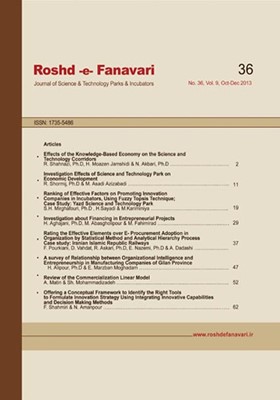-
-
List of Articles
-
Open Access Article
1 - Effects of the Knowledge-Based Economy on the Science and Technology Corridors
Rohollah Shahnazi Homa Mouazen Neumatollah Akbari -
Open Access Article
2 - Investigation Effects of Science and Technology Park on Economic Development
Ramezanali Shourmij Mahsa Asadi -
Open Access Article
3 - Ranking of Effective Factors on Promoting Innovation Companies in Incubators, Using Fuzzy Topsis Technique; Case Study: Yazd Science and Technology Park
Seyed Habibollah Mirghafori Hosein Sayadi Toranloo Maryam Kariminia -
Open Access Article
4 - Investigation about Financing in Entrepreneurial Projects
Hassanali Aghajani Mohsen Abbasgholi pour Mohadesse Fahimi Rad -
Open Access Article
5 - Rating the Effective Elements over E- Procurement Adoption in Organization by Statistical Method and Analytical Hierarchy Process Case study: Iranian Islamic Republic Railways
Farzaneh Pourkiyani Davood Vahdat Reza Askari Moghadam Eslam Nazemi alireza dadashi -
Open Access Article
6 - A survey of Relationship between Organizational Intelligence and Entrepreneurship in Manufacturing Companies of Gilan Province
Hamidereza Alipour Effat Marzban Moghadam -
Open Access Article
7 - Review of the Commercialization Linear Model
Ayda Matin Shadi Mohammad zadeh -
Open Access Article
8 - Offering a Conceptual Framework to Identify the Right Tools to Formulate Innovation Strategy Using Integrating Innovative Capabilities and Decision Making Methods
Farhad Shahmiry Naser Amnpour
-
The rights to this website are owned by the Raimag Press Management System.
Copyright © 2017-2025







